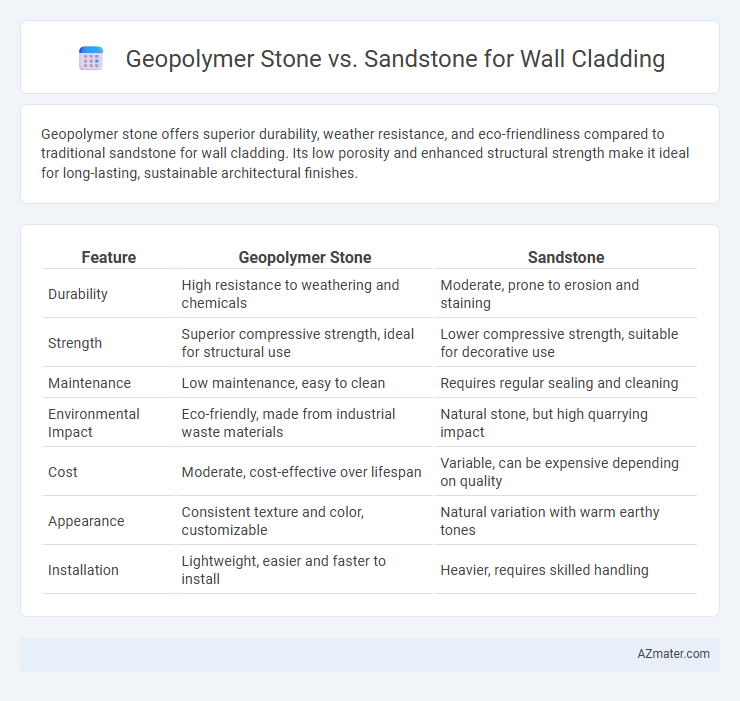Geopolymer stone offers superior durability, weather resistance, and eco-friendliness compared to traditional sandstone for wall cladding. Its low porosity and enhanced structural strength make it ideal for long-lasting, sustainable architectural finishes.
Table of Comparison
| Feature | Geopolymer Stone | Sandstone |
|---|---|---|
| Durability | High resistance to weathering and chemicals | Moderate, prone to erosion and staining |
| Strength | Superior compressive strength, ideal for structural use | Lower compressive strength, suitable for decorative use |
| Maintenance | Low maintenance, easy to clean | Requires regular sealing and cleaning |
| Environmental Impact | Eco-friendly, made from industrial waste materials | Natural stone, but high quarrying impact |
| Cost | Moderate, cost-effective over lifespan | Variable, can be expensive depending on quality |
| Appearance | Consistent texture and color, customizable | Natural variation with warm earthy tones |
| Installation | Lightweight, easier and faster to install | Heavier, requires skilled handling |
Introduction to Wall Cladding Materials
Geopolymer stone and sandstone are popular materials for wall cladding, offering distinct benefits in durability and appearance. Geopolymer stone, an eco-friendly alternative, provides high resistance to weathering and chemical corrosion, making it ideal for modern architectural applications. Sandstone, valued for its natural aesthetic and thermal insulation properties, remains a traditional choice, offering unique textures and color variations for exterior and interior wall surfaces.
Overview of Geopolymer Stone
Geopolymer stone is an innovative, eco-friendly building material composed of industrial byproducts like fly ash and slag, offering superior durability and low environmental impact compared to traditional sandstone. Its high compressive strength and resistance to weathering make it ideal for wall cladding applications, providing enhanced longevity and reduced maintenance costs. Unlike natural sandstone, geopolymer stone can be engineered for uniform texture and color consistency, ensuring aesthetic flexibility and sustainability in modern construction.
Overview of Natural Sandstone
Natural sandstone, a sedimentary rock composed primarily of sand-sized mineral particles, is widely favored for wall cladding due to its durability, natural aesthetic, and ability to withstand varying weather conditions. Its porous structure allows for excellent breathability, reducing moisture buildup and enhancing the longevity of exterior walls. Sandstone's unique color variations and textures provide versatile design options, making it a timeless choice in architectural applications.
Physical Properties Comparison
Geopolymer stone exhibits higher compressive strength and greater resistance to weathering compared to natural sandstone, making it more durable for wall cladding applications. Its lower porosity reduces water absorption, enhancing freeze-thaw durability and minimizing efflorescence risks. While sandstone offers natural aesthetic variation, geopolymer stone provides consistent density and improved mechanical performance for long-lasting exterior finishes.
Durability and Weather Resistance
Geopolymer stone offers superior durability and weather resistance compared to traditional sandstone, as its synthetic composition provides enhanced resistance to moisture, freeze-thaw cycles, and chemical erosion. Sandstone, a natural sedimentary rock, is more porous and susceptible to weathering, which can lead to surface degradation and reduced structural integrity over time. The advanced polymer matrix in geopolymer stone ensures longer-lasting wall cladding performance in harsh environmental conditions, making it a preferable choice for exterior applications.
Aesthetic Appeal and Design Options
Geopolymer stone offers a modern aesthetic with consistent color and texture, making it ideal for contemporary wall cladding designs, while sandstone provides a natural, earthy appearance with unique grain patterns that enhance rustic and traditional styles. Geopolymer stone allows greater customization in shape, size, and finish, supporting innovative architectural designs and precision installation. Sandstone's inherent variations create distinctive visual depth but limit design flexibility due to natural imperfections and weathering characteristics.
Installation Process and Ease
Geopolymer stone offers a more straightforward installation process compared to traditional sandstone due to its lightweight properties and uniformity in size, allowing for faster alignment and reduced labor effort. Sandstone, being heavier and naturally irregular, often requires specialized tools and additional time for cutting and fitting, which can complicate the installation. The ease of handling geopolymer stone also minimizes the risk of damage during installation, contributing to lower overall project costs and enhanced efficiency.
Environmental Impact and Sustainability
Geopolymer stone offers significantly lower carbon emissions compared to traditional sandstone due to its use of industrial by-products like fly ash and slag, reducing reliance on natural quarrying. Its production consumes less water and energy, enhancing sustainability in wall cladding applications. Sandstone extraction leads to habitat disruption and higher ecological footprints, making geopolymer stone a greener alternative for environmentally conscious construction.
Cost Analysis and Maintenance
Geopolymer stone offers a cost-effective alternative to natural sandstone for wall cladding, with lower initial material expenses and reduced long-term maintenance costs due to its high durability and resistance to weathering. Sandstone requires periodic sealing and cleaning to prevent erosion and staining, increasing maintenance efforts and expenses over time. Investment in geopolymer stone can result in substantial savings in both installation and upkeep, making it an economically advantageous choice for sustainable building projects.
Best Applications and Final Recommendations
Geopolymer stone offers superior durability and weather resistance compared to traditional sandstone, making it ideal for exterior wall cladding in harsh climates and urban environments. Its low porosity and high compressive strength reduce maintenance needs and enhance structural longevity, especially in commercial and industrial buildings. For aesthetic choices requiring natural texture and warmth, sandstone remains excellent for interior walls or sheltered exterior areas where exposure to elements is minimal.

Infographic: Geopolymer stone vs Sandstone for Wall Cladding
 azmater.com
azmater.com